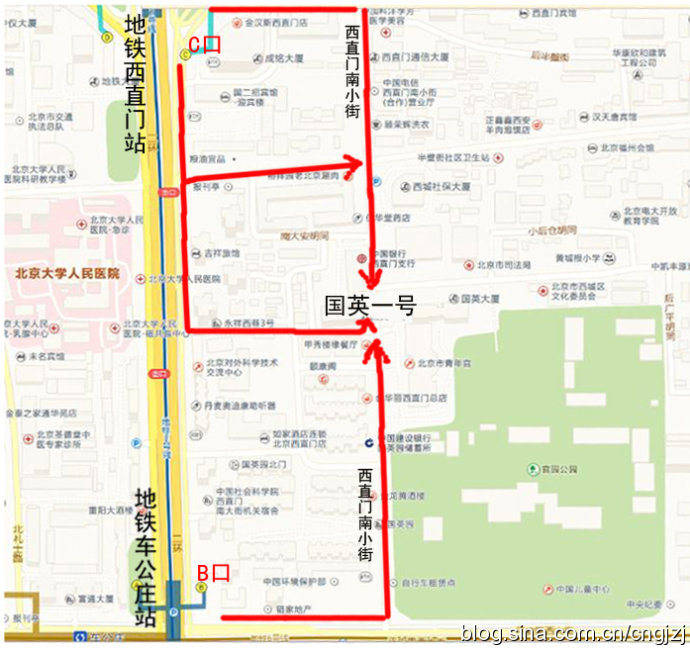中国民间中医医药研究开发协会国际针灸合作委员会
办公地点现在已经搬迁至西城区西直门南小街国英园一号楼824室,
同时为方便大家联系,固定电话已经变更
新号码010—58562339。特此通知。
地址:北京西城区西直门南小街国英园一号楼824室
邮编:100035
电话:010-58562339
传真:010-58562339
邮箱:cngjzj@163.com
网站(点击网址直接链接↓):http://www.cngjzj.com/
博客(点击网址直接链接↓):http://blog.sina.com.cn/cngjzj
交通路线图 (点击观看大图)

从首都机场乘坐机场专线,在东直门站下车换乘地铁2号线开往西直门方向,在西直门站 C 口出站:
1、沿西直门内大街向东直行100米,右拐到西直门南小街,向南步行到丁字路口即到国英园1号楼楼下。
2、向南直行50米,绕过 国二招宾馆 沿着中大安胡同向东到西直门南小街,向南步行到丁字路口即到国英园1号楼楼下。
从首都机场内乘坐机场直达西单的大巴,在西单站下车,乘坐出租车到西直门南小街国英园1号楼。
公交官园站:107路,运通106路
公交西直门南:387路,44路,800内环,816路,820内环,845路
地铁车公庄:地铁二号线
地铁西直门:地铁二号线
公交车公庄东:107路,118路,701路
公交车公庄北:209路,375路,392路
 您现在的位置是:
首页 >>
Chinese health 中医保健 >>
Family health medicine 家庭
您现在的位置是:
首页 >>
Chinese health 中医保健 >>
Family health medicine 家庭
2016年06月28日
 复制链接
复制链接
 打印
打印
 大 中 小
大 中 小
Eat more fruit can be reduced the risk of heart disease and stroke
, a professor at the university of Oxford in England Chen Zhengming
The 2016-06-24
Source: health
The New England journal of medicine published an article based on the latest research report shows that Chinese people often eat fresh fruit significantly lower risk of heart disease and stroke. The report of the data from a large prospectie cohort study includes 500000 people (also called Chinese adult chronic prospective studies, CKB). The study queue created jointly by Oxford University and Chinese academy of medical sciences, 10 regional recruiting respondents and acquisition in China, including diet, a large number of individual data related to health, and with death, and links to common slow disease report and the health care system, to obtain subjects during the seven-year follow-up data such as morbidity and mortality. Study, detailed analysis of the fresh fruit intake levels and the risk of cardiovascular disease morbidity and mortality in the relationship. Analysis of the objects involved when I just joined the centerless cerebrovascular disease history, also is not taking blood pressure drugs.
The study found that high fruit intake (mainly apples, oranges and pears, etc.) with high social and economic level, not smoking healthy life, but also to lower blood pressure and blood glucose levels are closely related. In ruled out the impact of these potential confounding and the intermediary factors, 100 grams per day (2) two fresh fruit can reduce cardiovascular disease risk of death by about a third. The study found that in different areas and different gender of respondents, fresh fruit and the correlation between cardiovascular disease are very similar.
The study's lead author, Dr Du Huaidong Oxford University research institute said: "this study reveals the connection degree of fruit intake and risk of cardiovascular disease than previously reported similar findings in western populations to stronger, this may be due to the Chinese people fruit intake level significantly lower compared with Western Europe and the United States population. In addition, the Chinese mainly by way of raw intake of fresh fruit, but not like westerners, there are quite a part of the fruit is processed (e.g., canned fruit and fruit juice).
The study's co-author, one of the major persons-in-charge of the project, the Chinese academy of medical sciences professor li-ming said: "the global burden of disease study recent reports that fruit consumption level in China is one of the main risk factors of premature death in adults, but the conclusion is primarily based on western rather than Chinese large prospective population-based study results."
The author is the study's co-authors, one of the major persons-in-charge of the project. As observational epidemiological studies, we are not fully established fruit intake and lower the causal relationship between the risk of cardiovascular disease. If they indeed for cause and effect, and through health promotion make every Chinese can do daily intake of fresh fruit, a year can reduce more than 50 name heart vascular disease death. Including more than 20 thousands of premature deaths before the age of 70, at the same time can also avoid more events of the nonfatal heart attacks and strokes.